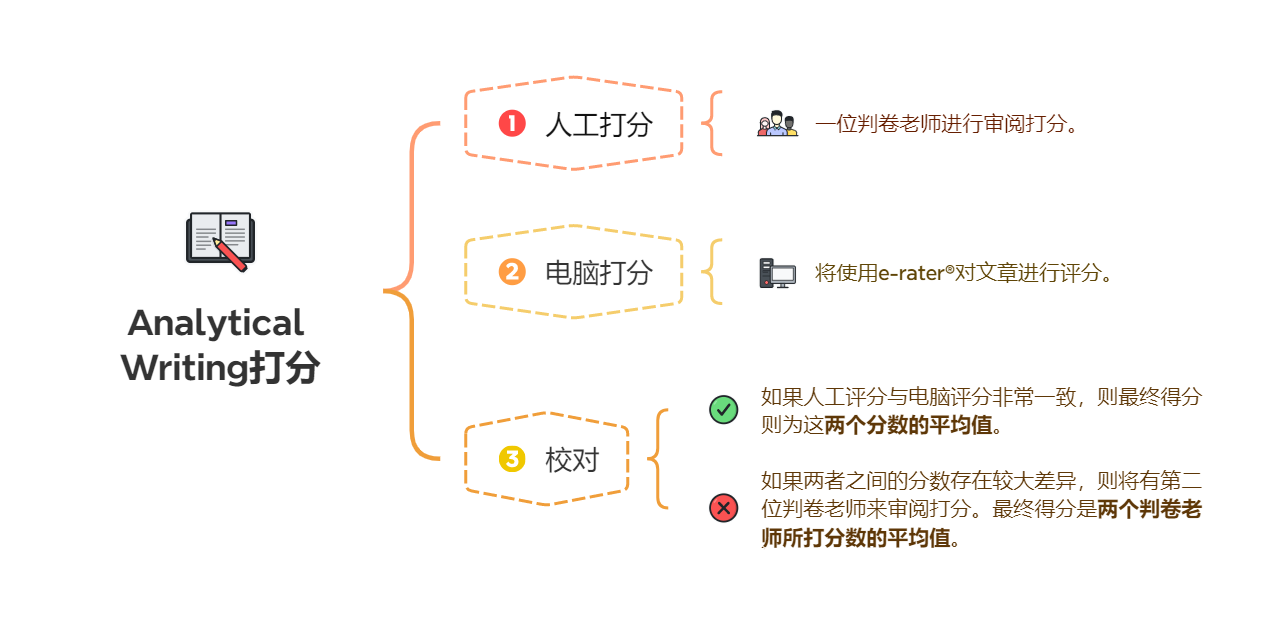改革后GRE考试到底是怎么算分的?!!
.jpeg)
目前为止,ETS官方并未公布GRE详细的算分规则。由于GRE是自适应性考试,也就是说系统会跟根据你这个Section的回答的情况,来决定你下个Section的题目难度。
且算分还结合了题目难度和作答时间,这导致很难明确说答对多少题,就能得多少分,只能依靠数据进行大致的推测。
结合大量GRE改革后考试的成绩和诊断报告书,必考题为大家总结了大概的算分规则,一次性讲清楚改革后你的GRE分数是怎么算出来的!
改革后GRE考试分数结构
每一场GRE考试大致会有以下几个部分:
- Verbal (两个section)
- Quantitative(两个section)
- Writing(一篇Issue)
而Verbal和Quantitative全部以选择题的形式考察,通过电脑自动算分,因此考完试马上就能知道成绩。满分170分,基础分130分。全错也会得130分。但如果全部不作答报告将显示No Score (NS)。
Writting部分是人工+电脑打分,满分6分,基础分0分。
改革后GRE自适应机制
在GRE实际考试中,第二个section的难度模式取决于第一个section的正确率,那我们首先要确定这两者之间具体的相关性。
根据收集到的大部分学生分数数据分析,我们推测改革后自适应机制大致如下:


GRE的算分之所以复杂,是因为它不仅基于题目的对错数量,更是结合了题目难度和作答时间,因此表格的数据仅供参考,具体情况还要看做对题目的难度系数。
改革后GRE算分公式
虽然ETS没有公布具体的计分方式,但根据我们收集到的GRE分数诊断报告,结合以往经验大致推算出以下计分公式:
Verbal
①Section1对9道及以上(错0~3题),Section2进入自适应Hard的情况下
扣的分数≈错题道数-1
例如:Section1错2题,Section2错4题,得分很可能是163分=170-6-1
②Section1对5~8道(错4~7道),Section2进入自适应Medium的情况下
扣的分数≈错题道数-4
例如:Section1错6题,Section2错5题,得分很可能是155分=170-11-4

注:以上数据仅供参考,实际考试分数需结合具体题目难度综合判断。
Quantitative
大部分中国学生第一个section都能答对8题及以上,因此第二个section基本上都能进入hard模式。
因此,假设考生第二个section进入hard模式,那么Quantitative的计分公式则为:
① 每错一道难度系数4或5的题,扣1分
② 每错一道难度系数2或3的题,平均扣2分
例如:Section 1错一道难度系数4的题,Section 2错一道难度系数4、一道难度系数5的题,得分很可能是167分=170-1*3

注:以上数据仅供参考,实际考试分数需结合具体题目难度综合判断。
Analytical Writing
Analytical Writing部分的评分环节分为三步。
第一步:人工打分
首先将会有一位判卷老师将审阅打分。这里的每一位判卷老师都经过专业培训和认真筛选的。
第二步:电脑打分
然后将使用e-rater®对文章进行评分。e-rater®是ETS开发的一种计算机程序,能够识别文章特征,并判断写作水准。
第三步:校对
如果人工评分与电脑评分非常一致,则最终得分则为这两个分数的平均值。
如果两者之间的分数存在较大差异,则将有第二位判卷老师来审阅打分,最终得分是两个判卷老师所打分数的平均值。

ETS官方也列出了具体每个分数档位的文章,需要满足的标准:
Issue 6分标准
- articulates a clear and insightful position on the issue in accordance with the assigned task根据指定任务对问题表达了清晰且富有深度的立场
- develops the position fully with compelling reasons and/or persuasive examples用有力的理由和/或有说服力的论据充分发展这一立场
- sustains a well-focused, well-organized analysis, connecting ideas logically 保持了焦点明确、有组织的分析,并逻辑地连接了各个观点
- conveys ideas fluently and precisely, using effective vocabulary and sentence variet 能够使用有效词汇和多种句式,流畅且精确地传达思想
- demonstrates superior facility with the conventions of standard written English (i.e., grammar, usage and mechanics), but may have minor errors 在标准书面英语(即语法、用法和结构)方面表现出卓越的运用能力,但可能有细微错误
Issue 5分标准
- presents a clear and well-considered position on the issue in accordance with the assigned task 根据指定任务对问题表达了清晰且深思熟虑的立场
- develops the position with logically sound reasons and/or well-chosen examples 用逻辑上合理的理由和/或恰当的例子发展这一立场
- is focused and generally well organized, connecting ideas appropriately 基本上焦点明确,组织清晰,并恰当地串联文中的要点
- conveys ideas clearly and well, using appropriate vocabulary and sentence variety能够使用恰当的词汇和多样的句式进行清晰的表达
- demonstrates facility with the conventions of standard written English, but may have minor errors在标准书面英语方面表现出良好的掌握,但可能有细微错误
Issue 4分标准
- presents a clear position on the issue in accordance with the assigned task提出了清晰的立场并紧扣了写作要求
- develops the position with relevant reasons and/or examples用相关的理由和/或例子论证这一立场
- is adequately focused and organized有焦点并一定程度上地组织了文中的要点
- demonstrates sufficient control of language to express ideas with acceptable clarity能有效地使用语言进行清晰的表达
- generally demonstrates control of the conventions of standard written English, but may have some errors能够有效地使用标准书面英语(即语法、用法和结构)方面表现出卓越的运用能力,但是有一些错误
Issue 3分标准
- is vague or limited in addressing the specific task directions and in presenting or developing a position on the issue or both没有提出清晰的立场,且没有紧扣写作要求
- is weak in the use of relevant reasons or examples or relies largely on unsupported claims没有有效地使用说理和例子来论证立场,论证中主要依赖未经支持的主张
- is limited in focus and/or organization内容缺乏焦点/或组织方面有限
- has problems in language and sentence structure that result in a lack of clarity在语言和句子结构上存在问题,导致缺乏清晰度
- contains occasional major errors or frequent minor errors in grammar, usage or mechanics that can interfere with meaning语法,用法以及其他规则上出现偶尔的大错误或者存在频繁的细小错误,并影响了文章理解
Issue 2分标准
- is unclear or seriously limited in addressing the specific task directions and in presenting or developing a position on the issue or both忽略了写作要求的同时没有清晰地展现或发展立场
- provides few, if any, relevant reasons or examples in support of its claims在支持立场方面提供的相关理由或例子很少
- is poorly focused and/or poorly organized内容在焦点/或组织表现得很差
- has serious problems in language and sentence structure that frequently interfere with meaning语言表达中存在严重问题导致理解困难
- contains serious errors in grammar, usage or mechanics that frequently obscure meaning 语法,用法以及其他规则上存在严重错误,并影严重响文章理解
Issue 1分标准
- provides little or no evidence of understanding the issue不理解题目以及写作要求
- provides little or no evidence of the ability to develop an organized response (e.g., is disorganized and/or extremely brief)无法对立场或者要点提供论证
- has severe problems in language and sentence structure that persistently interfere with meaning语言表达中持续存在严重问题导致无法理解
- contains pervasive errors in grammar, usage or mechanics that result in incoherence在语言上存在严重且频繁的错误导致文章无法理解
GRE分数要求
不同专业方向对GRE的分数有不同要求。对于文科方向而言,名校的GRE分数要求一般在330+以上,并且看重Verbal和Writing。对于理工科方向而言,GRE的分数要求基本在320到330分之间,同时看重Quantitative。
ETS还有官方的改革后GRE模考,叫做PowerPrep,包括五份练习真题(两套免费三套付费)。POWERPREP模拟了真实的考试情形,可以相对准确地预测GRE分数。
对于在国内完成基础教育的考生而言,Quantitative部分通常都可以拿到不错的分数,但中国考生Verbal部分的平均分明显较低,因此需要着重加强练习。
.jpeg)
解开关于GRE计分规则的疑惑有助于同学们更加有方向地备战GRE。
同时,大家不能轻视GRE考试中的任何一个部分,在深入了解GRE这门考试的基础上,认真充分地学习、备考,争取拿到满意的分数,收获梦校offer!












